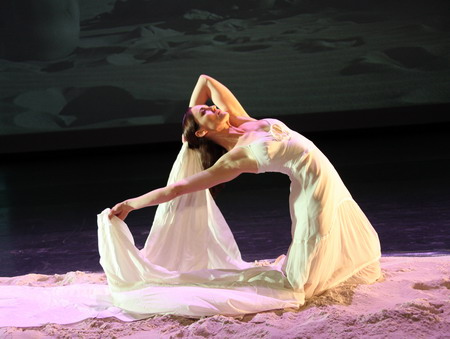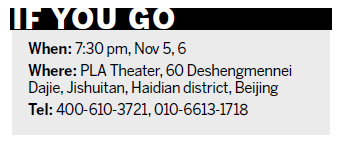Life and Leisure
United we dance
By Xu Lin (China Daily)
Updated: 2010-11-05 07:48
 |
Large Medium Small |
|
 The stage setting of white sand, black background and colorful costumes is a visual treat. Provided to China Daily |
The Australian ritual of going to the beach and the Chinese ritual of going to the temple are combined in a dance work by the two countries. Xu Lin reports
China's BeijingDance/LDTX and Australia's Expressions Dance Company (EDC) will present the world premiere of their collaboration First Ritual, a three-part modern dance exploring the meaning of rituals in China and Australia, on Nov 5 and 6.
There are 24 dancers, including six Australians, in this featured performance of the Year of Australian Culture in China. It will also be presented at the 2011 Australia's Brisbane Festival and the 2011 Year of Chinese Culture in Australia.
"It is the biggest Sino-Australia culture exchange activity in recent years," says Jill Collins, counselor of public affairs and culture, Australian embassy, Beijing. "The cooperation between the two companies will be a lasting legacy for both parties."
China's first independent professional modern dance company, BeijingDance/LDTX was co-founded by Willy Tsao and Li Hanzhong in 2005, two pioneering dancers. The company has performed in China, Europe and North America.
EDC was founded 26 years ago and has performed in more than 15 countries and regions. Its artistic director, Natalie Weir, is a prolific choreographer with more than 150 works at home and abroad.
"I met Weir at the 2009 Busan International Dance Festival when the two companies were invited to perform. We were like old friends during our first meeting and decided to collaborate with each other," Tsao says.
The two companies rehearsed separately for six months, before getting together. The first two sections have strong Australian and Chinese flavors, respectively, while the third section is a combination of both.
The first part depicts the rituals on an Australian beach, such as courtship, weddings, funerals and friendship.
"Most of Australia's population lives close to the coastline and the beach plays a very important role in our lives," Weir says.

Across the front of the stage is a layer of sand, which represents not only a beach in Australia, but also the Earth.
"I think human beings belong to the Earth. This is the connection we have for each other," Weir says.
Part two is co-choreographed by Li, with his wife Ma Bo, who were inspired by Cloud Gate, an ancient Chinese dance, and sacrifice rituals from 5,000 years ago. It displays a Chinese temple where 18 dancers offer incense to Buddha. The dancers are divided into two groups. A washbasin of dyed water is sprinkled at puppets that represent restlessness. Finally, they cultivate some stillness after struggling with themselves.
"Visiting the temple is a common Chinese ritual and China as a nation always seeks tranquility and harmony," Li says.
As for the last section, it was co-choreographed by Tsao and Weir as a collaborative performance. They started negotiating the theme, music and stage decoration six months ago through e-mails.
When the Australian dancers arrived in Beijing in early October, they started the final choreography and had just one month to practice.
Section three is inspired by daily life in a modern society, such as the crowded shopping mall and freeway. All of a sudden, a pair of dancers dashes out of the throng, creating a sharp comparison with the crowd.
The two choreographers say they are satisfied with their collaboration.
"Australian dancers are taller and they move big while the Chinese are very flexible. But they can come together pretty well as everyone understands the language of dancing," Weir says.
"It is very interesting to see the merging of two different cultures. And we tackle the commonality rather than the differences," Tsao says.
Finally, everyone holds a handful of sand and scatters it all over the stage.
"Australia is full of desert and Beijing has been haunted by sandstorms for years. The sand in a city reminds me of nature and environmental protection," Tsao says.
Another feature is the music, composed by Philip Glass from the United States and Tan Dun from China. The white sands, black background and red costumes are a feast for the eyes.
It is expected the dance will be performed in Australia again next year.
"We are seeking long-term cooperation with each other," Tsao says.